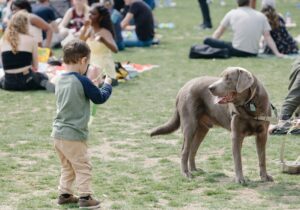Dog Parks, Daycares, and Playdates: What You Need to Know
Socializing your dog doesn’t always mean structured training or walks through busy neighborhoods. Sometimes, it looks like a tail-wagging romp through a dog park or a friendly game of chase with another pup in someone’s backyard. But while these play-based social experiences can be incredibly rewarding, they also come with their own set of considerations.
Whether you’re thinking about enrolling your dog in daycare, planning a playdate, or checking out a local dog park, it’s important to understand how to use these settings effectively and safely. Not all social environments are created equal—and not every dog enjoys or benefits from the same types of interactions.
Dog Parks: Pros, Cons, and Precautions
The Pros:
-
Open space for exercise and freedom off-leash
-
Interaction with other dogs of all breeds and sizes
-
Mental stimulation from varied sights, sounds, and smells
-
Opportunities to practice recall and basic obedience in a real-world setting
The Cons:
-
Unpredictable dog behavior – not all dogs are well-trained or socialized
-
Uninformed or inattentive owners
-
Risk of illness or parasites if park isn’t maintained
-
Possibility of fights or negative experiences that can set socialization back
Safety Tips:
-
Visit during off-peak hours (weekday mornings or mid-afternoons) to avoid chaos.
-
Observe the dogs already inside before entering—are they playing appropriately?
-
Always supervise your dog and watch for signs of stress or over-arousal.
-
Stick to parks with separate areas for small and large dogs.
-
Don’t bring toys or treats that might spark resource guarding.
-
Leave if your dog seems overwhelmed or another dog is too rough.
Dog Daycare: A Good Fit for Every Pup?
-
Structured play in a supervised environment
-
Great for high-energy dogs who need exercise during the day
-
Builds comfort around a consistent group of dogs and handlers
-
Offers relief for dogs that suffer from separation anxiety
The Cons:
-
Not suitable for all temperaments – some dogs find daycares overstimulating
-
Group play increases risk of contagious illness or injury
-
Inconsistency in staff training and facility quality between providers
What to Look For:
-
Staff-to-dog ratio: Fewer dogs per staff member is better
-
Screening process: Daycares should evaluate each dog before accepting them
-
Playgroup separation: Dogs should be grouped by size, energy level, and temperament
-
Clean, secure facility: Look for clean floors, fencing, and ventilation
-
Rest time built into the day: Overstimulated dogs need breaks to recharge
If your dog is shy, anxious, or tends to avoid other dogs, a daycare environment may not be the best choice—at least not yet. Start small, and consider daycares that offer private playtime or enrichment-based activities.
Organizing Dog Playdates: Personalized Socialization
The Pros:
-
One-on-one interaction in a controlled setting
-
Can be tailored to your dog’s social comfort level
-
Safer for dogs with specific triggers or anxiety
-
Great for reinforcing good play habits and obedience
The Cons:
-
Requires effort to match dogs with compatible energy and play styles
-
Potential for resource guarding if toys or food are present
-
Some dogs may become overexcited or territorial on their home turf
Playdate Planning Tips:
-
Start with a short walk side-by-side before going off-leash to break the ice.
-
Choose neutral territory for first-time meetings, like a park or backyard neither dog has claimed.
-
Watch for appropriate play: relaxed body language, role switching (chasing and being chased), and frequent breaks.
-
Step in if play becomes too rough or one dog is trying to escape the interaction.
-
End on a positive note—don’t wait for either dog to get overwhelmed.
Reading Dog Body Language During Play
Regardless of the setting, always watch how your dog is behaving. Signs of healthy play include:
-
Play bows (elbows down, rear in the air)
-
Loose, wiggly movements
-
Relaxed ears and tails
-
Voluntary breaks or pausing to sniff or reset
Red flags to watch out for:
-
Tucked tails, pinned ears, or cowering
-
Freezing or trying to hide
-
Raised hackles, stiff bodies, or growling
-
Relentless chasing or mounting
-
One dog doing all the chasing or pinning without breaks
Not all dogs play the same way, and that’s okay—but both dogs should appear comfortable and willing.
Alternatives for Dogs Who Don’t Enjoy Group Settings
If your dog doesn’t thrive in high-energy social settings, don’t worry. You can still provide them with enrichment and positive exposure through:
-
Leash walks in dog-friendly areas where they can observe other dogs
-
Structured training classes with small group sizes
-
Solo sniffaris (walks where your dog leads and sniffs at their own pace)
-
One-on-one time with trusted dogs they know and like
-
Dog sports or enrichment games for mental stimulation
Final Thoughts
Dog parks, daycares, and playdates can be valuable tools in your dog’s social life—but only when used thoughtfully. Every dog is different. Some thrive in bustling dog parks, while others prefer the quiet companionship of one gentle friend. The goal is to find what works best for your dog’s personality, comfort level, and needs.
Always supervise play, advocate for your dog, and prioritize safety over social expectations. Positive experiences build confidence. And whether it’s a group play session or a calm neighborhood walk, these moments shape your dog’s relationship with the world.


